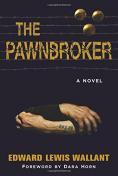BKMT READING GUIDES
The Pawnbroker: A Novel
by Edward Lewis Wallant
Published: 2015-11-10
Paperback : 279 pages
Paperback : 279 pages
0 members reading this now
1 club reading this now
0 members have read this book
1 club reading this now
0 members have read this book
For most of us, remembering the Holocaust requires effort; we listen to stories, watch films, read histories. But the people who came to be called ?survivors” could not avoid their memories. Sol Nazerman, protagonist of Edward Lewis Wallant’s The Pawnbroker, is one such sufferer.
At ...
At ...
No other editions available.
Jump to
Introduction
For most of us, remembering the Holocaust requires effort; we listen to stories, watch films, read histories. But the people who came to be called ?survivors” could not avoid their memories. Sol Nazerman, protagonist of Edward Lewis Wallant’s The Pawnbroker, is one such sufferer.
At 45, Nazerman, who survived Bergen-Belsen although his wife and children did not, runs a Harlem pawnshop. But the operation is only a front for a gangster who pays Nazerman a comfortable salary for his services. Nazerman’s dreams are haunted by visions of his past tortures. (Dramatizations of these scenes in Sidney Lumet’s 1964 film version are famous for being the first time the extermination camps were depicted in a Hollywood movie.)
Remarkable for its attempts to dramatize the aftereffects of the Holocaust, The Pawnbroker is likewise valuable as an exploration of the fraught relationships between Jews and other American minority groups. That this novel, a National Book Award finalist, remains so powerful today makes it all the more tragic that its talented author died, at age 36, the year after its publication. The book sold more than 500,000 copies soon after it was published.
At 45, Nazerman, who survived Bergen-Belsen although his wife and children did not, runs a Harlem pawnshop. But the operation is only a front for a gangster who pays Nazerman a comfortable salary for his services. Nazerman’s dreams are haunted by visions of his past tortures. (Dramatizations of these scenes in Sidney Lumet’s 1964 film version are famous for being the first time the extermination camps were depicted in a Hollywood movie.)
Remarkable for its attempts to dramatize the aftereffects of the Holocaust, The Pawnbroker is likewise valuable as an exploration of the fraught relationships between Jews and other American minority groups. That this novel, a National Book Award finalist, remains so powerful today makes it all the more tragic that its talented author died, at age 36, the year after its publication. The book sold more than 500,000 copies soon after it was published.
Discussion Questions
1) In some ways, Sol Nazerman is a challenging protagonist: although his circumstances make the reader want to pity him, it becomes clear early on in the novel that he certainly does not want and may or may not deserve our pity. How might this have affected your reading of the novel? Did you sympathize with Sol? If not, what drove you to care about his story? How does Wallant challenge our notions about the nature of sympathy, the nature of pity, and the distinction between them?2) When this novel was published in 1961, there were few American cultural markers of the Holocaust: no Holocaust miniseries, no Schindler’s List, no U.S. Holocaust Memorial Museum. Imagine (and discuss) the impact of this novel on a readership that may not have had much awareness of the experiences of European Jews deported to concentration/extermination camps. (If your group includes members who recall the book’s original publication, imagining may not be necessary.)
3) What kinds of tensions within American Jewry at the time—circa 1960—does Wallant suggest in his portrait of Sol’s relationship with his sister and her family? Has anything changed today?
4) What do you make of the novel’s multicultural cast of characters and the relationships between characters who hail from different races/religions/ethnicities?
5) If this novel were being published for the first time now (2015), how might you read/react to it differently?
6) Have you seen the Sidney Lumet’s 1964 film—starring Rod Steiger as Sol Nazerman—that was based on this novel? If so, what do you think of the modifications that were made to The Pawnbroker from page to screen? What may have been lost (or gained) in the “translation”?
7) How is this novel different from other “Holocaust novels” you may have read?
8) What do you make of the fact that Sol’s last name is “Nazerman” (perhaps invoking Nazareth) and the extent to which the novel’s climax depends on a key event involving a character named Jesus? What do you think Wallant is trying to do here with Christian symbolism in this Jewish book?
9) “[Edward Lewis] Wallant was often compared in his brief lifetime with his contemporary Saul Bellow,” notes Dara Horn in her foreword to this edition of The Pawnbroker. How might you compare Wallant’s work in The Pawnbroker with that of Bellow? Of other major American Jewish writers?
10) If you could ask Edward Lewis Wallant one question directly, what might it be?
Book Club Recommendations
Recommended to book clubs by 0 of 0 members.
MEMBER LOGIN
BECOME A MEMBER it's free
Book Club HQ to over 90,000+ book clubs and ready to welcome yours.
SEARCH OUR READING GUIDES
Search
FEATURED EVENTS
PAST AUTHOR CHATS
JOIN OUR MAILING LIST
Get free weekly updates on top club picks, book giveaways, author events and more
Get free weekly updates on top club picks, book giveaways, author events and more
Please wait...








